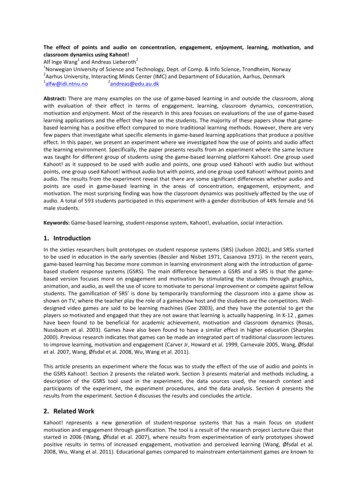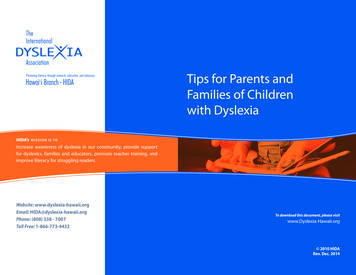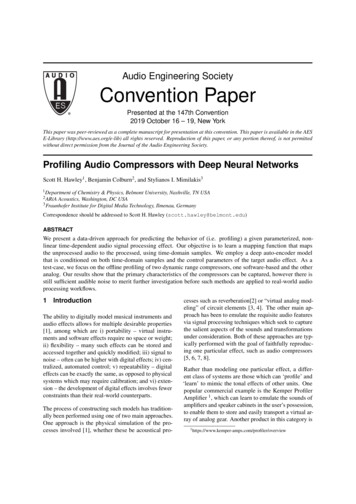
Transcription
The effect of points and audio on concentration, engagement, enjoyment, learning, motivation, andclassroom dynamics using Kahoot!12Alf Inge Wang and Andreas Lieberoth1Norwegian University of Science and Technology, Dept. of Comp. & Info Science, Trondheim, Norway2Aarhus University, Interacting Minds Center (IMC) and Department of Education, Aarhus, : There are many examples on the use of game-based learning in and outside the classroom, alongwith evaluation of their effect in terms of engagement, learning, classroom dynamics, concentration,motivation and enjoyment. Most of the research in this area focuses on evaluations of the use of game-basedlearning applications and the effect they have on the students. The majority of these papers show that gamebased learning has a positive effect compared to more traditional learning methods. However, there are veryfew papers that investigate what specific elements in game-based learning applications that produce a positiveeffect. In this paper, we present an experiment where we investigated how the use of points and audio affectthe learning environment. Specifically, the paper presents results from an experiment where the same lecturewas taught for different group of students using the game-based learning platform Kahoot!. One group usedKahoot! as it supposed to be used with audio and points, one group used Kahoot! with audio but withoutpoints, one group used Kahoot! without audio but with points, and one group used Kahoot! without points andaudio. The results from the experiment reveal that there are some significant differences whether audio andpoints are used in game-based learning in the areas of concentration, engagement, enjoyment, andmotivation. The most surprising finding was how the classroom dynamics was positively affected by the use ofaudio. A total of 593 students participated in this experiment with a gender distribution of 44% female and 56male students.Keywords: Game-based learning, student-response system, Kahoot!, evaluation, social interaction.1. IntroductionIn the sixties researchers built prototypes on student response systems (SRS) (Judson 2002), and SRSs startedto be used in education in the early seventies (Bessler and Nisbet 1971, Casanova 1971). In the recent years,game-based learning has become more common in learning environment along with the introduction of gamebased student response systems (GSRS). The main difference between a GSRS and a SRS is that the gamebased version focuses more on engagement and motivation by stimulating the students through graphics,animation, and audio, as well the use of score to motivate to personal improvement or compete against fellowstudents. The gamification of SRS’ is done by temporarily transforming the classroom into a game show asshown on TV, where the teacher play the role of a gameshow host and the students are the competitors. Welldesigned video games are said to be learning machines (Gee 2003), and they have the potential to get theplayers so motivated and engaged that they are not aware that learning is actually happening. In K-12 , gameshave been found to be beneficial for academic achievement, motivation and classroom dynamics (Rosas,Nussbaum et al. 2003). Games have also been found to have a similar effect in higher education (Sharples2000). Previous research indicates that games can be made an integrated part of traditional classroom lecturesto improve learning, motivation and engagement (Carver Jr, Howard et al. 1999, Carnevale 2005, Wang, Øfsdalet al. 2007, Wang, Øfsdal et al. 2008, Wu, Wang et al. 2011).This article presents an experiment where the focus was to study the effect of the use of audio and points inthe GSRS Kahoot!. Section 2 presents the related work. Section 3 presents material and methods including, adescription of the GSRS tool used in the experiment, the data sources used, the research context andparticipants of the experiment, the experiment procedures, and the data analysis. Section 4 presents theresults from the experiment. Section 4 discusses the results and concludes the article.2. Related WorkKahoot! represents a new generation of student-response systems that has a main focus on studentmotivation and engagement through gamification. The tool is a result of the research project Lecture Quiz thatstarted in 2006 (Wang, Øfsdal et al. 2007), where results from experimentation of early prototypes showedpositive results in terms of increased engagement, motivation and perceived learning (Wang, Øfsdal et al.2008, Wu, Wang et al. 2011). Educational games compared to mainstream entertainment games are known to
suffer from running on very few platforms (usually Windows PCs), too simplistic, being single player andoffline, offering low production value, and are typically more targeted towards parents, teachers and formallearning curriculum than being fun for the students (Kirriemuir and McFarlane 2004). This is especially truewhen educational games try to copy existing game concepts and add some learning on top of it. Kahoot! wasnot designed to copy any existing game, but rather to find a game concept that could fit a classroom settingand that could be alignment with Tom Malone’s theory of intrinsically motivating instructions (Malone 1980).Malone’s theory lists three categories that make things fun to learn: Challenge (goals with uncertainoutcomes), Fantasy (captivate through intrinsic or extrinsic fantasy), and Curiosity (sensor curiosity throughgraphics and audio, and cognitive curiosity). As the game should be used in the classroom, it was alsoimportant to incorporate social game play. The result was to develop a game concept where the fantasy is thatthe classroom temporarily is changed into a game show where the teacher is the game host and the studentsare the competitors. The challenge is to answer questions and compete against other players, and curiosity isprovided through inspiring graphics and audio, as well as solving a cognitive puzzle. The lack of variety in gameplay is compensated by the competitive nature of playing against a whole class of students. Reports fromthousands of teachers and students all over the world give an indication that the concept works as intended.Learning games are commonly used to review facts using multiple-choice questions similar to what is done inKahoot!. However, such games can also be used to teach skills, judgment, behaviors, theories, reasoning,process, procedures, creativity, language, systems, observation, and communication using various approaches(Prensky 2005).A wide variety of software now exists that employ some variation on game elements to motivate, supplyfeedback, and structure participation trajectories. Research in educational settings has shown that games andgame elements can influence subjective experience as well as behavior and learning outcomes, but thesefactors are often intermingled within studies. Further, individual game elements are rarely tested in isolation,making it difficult to determine the impact of individual design features, or their factorial interplay, relativelyto e.g. the basic functionalities of a student-response system or extrinsic motivators leveraged withinorganizations when they adapt gamified learning platforms. However, a few studies have begun to emerge,that test the psychological and behavioral impacts of individual game design elements in non-game settings(Deterding, Dixon et al. 2011) by adopting controlled experimental rigor in the lab or the field (Attali and ArieliAttali 2015, Lieberoth 2015, Mekler, Brühlmann et al. 2015). For instance, Lieberoth used a three-groupexperimental setup to dissociate the psychological effects of competitive game mechanics from thepsychological expectations created by the gamelike look of the activity. In this study using a combination ofbehavior and survey, intrinsic motivation was found to be significantly higher in conditions using the “gamelooking” elements than the control condition, regardless of whether any actual game mechanics used. Aweakness of such studies, however, is that individual design elements are rarely completely isolated in favor ofcomparing a “full game” with many moving parts to a (often passive) control condition. In Lieberoth’s gameframing study, for instance, the effect of the competitive mechanics were not isolated. In order to create a full2x2 factorial design, a fourth condition with game mechanics but with no game looks would have beenneeded, so all four resulting groups could be compared using a slightly different statistical technique. In orderto dissociate the effects of different design elements in Kahoot!, we therefore opted for a true 2x2 factorialdesign, switching sound and points off and on in a field experiment. The colorful look, social space andimmediate feedback remained staple, which arguably creates a certain baseline game feel (Swink 2009)somewhere between the “juiciness” of casual games (Juul 2010) and “shallow” gamification (Lieberoth 2015).But the setup allows us to uniquely investigate the subjective impact of two of Kahoot!’s moving parts: Pointsand audio/music.Points and other kinds of score tallying has been a staple of game design for what looks like millennia (Bell1980, Elias, Garfield et al. 2012), but the phenomenon is also well known in education, where it has beendebated in terms of immediate impact on classroom behavior versus long term achievement (McLaughlin andMalaby 1972, Greene, Sternberg et al. 1976, Deci, Koestner et al. 1999). This discussion has resurfaced in theuse and criticism of points and badges in gamification (Fuchs, Fizek et al. 2014, Lieberoth, Møller et al. 2015,Prestopnik and Tang 2015). The most comprehensive review of gamification results to data shows generallymixed results (Hamari, Koivisto et al. 2014). When discussing “full games” for purposes like citizen science,empirical studies indicate that points can have a supportive role in engagement, but that factors like scienceinterest and different kinds of narrative surrounding the task hold more motivational power (Iacovides,Jennett et al. 2013, Lieberoth, Pedersen et al. 2015, Prestopnik and Tang 2015). Likewise, studies from onlinetasks to learning contexts without “full game” structure have shown some behavioral impact of points in terms
of response speed (Attali and Arieli-Attali 2015) and number of tasks completed (Mekler, Brühlmann et al.2015), even though this did not necessarily mirror task performance, nor measures of intrinsic motivation orparticipants’ subjective participation motifs. This latter category of traditional gamification fits Kahoot!somewhat better than “full“ learning games, but Kahoot! also differs notably in its real-time merging ofquiz/polling with in-person lectures shared in the social setting of a lecture hall.One feature that might contribute to the shift from psychological “lecture mode” to a more game/playoriented frame is Kahoot!’s use of audio and music. The psychological impact of music has been studied atmultiple levels from its social psychological role in everyday life (Rentfrow 2012) to its biological underpinnings(Juslin and Västfjäll 2008, Janata, Tomic et al. 2012) and how at least three universal emotions can berecognized in and elicited by music across cultures (Fritz, Jentschke et al. 2009). Audio effects, and more or lessambient and dynamic music, has been a central part of digital game design for almost as long as technologyhas allowed (Collins 2009, Kamp 2014). Indeed, in Malone’s early work on games for learning, it was found thatmusic was among several motivating game factors, but most notably for female subjects (Malone 1981). Morerecently, music in video games has been linked to stress responses (Hébert, Béland et al. 2005) and aggressivebehavior (Zhang and Gao 2014). In he broader behavior design framework, situational music has been found tohave a bearing on gambling behavior (Dixon, Trigg et al. 2007), and both pleasant (North, Tarrant et al. 2004)and chilling (Fukui and Toyoshima 2014) music has been found to induce altruistic behavior in field- andbehavioral economy experiments respectively.Points and music are thus to well-studied phenomena that may each have their own role to play in theexperience of, and behavior in, Kahoot! use in lecture rooms.3. Material and MethodThis section presents the Kahoot! game-based learning platform, the data sources, the research context andparticipants, research procedures, and the method for data analysis.3.1 Research Questions and Research ApproachThe research goal of the experiment presented in this article was to investigate how the use of audio andpoints in the game-based learning platform Kahoot! affects the students. The research method used is basedon the Goal, Question Metrics (GQM) approach (Basili 1992) where we first define a research goal (conceptuallevel), then define a set of research questions (operational level), and finally describe a set of metrics toanswer the defined research questions (quantitative level).3.1.1 Research Goal and Research QuestionsThe research goal of this study was defined as the following using the GQL template (Basili 1992):The purpose of this study was to evaluate the effect of use of audio and points in a game-based learningplatform for teaching new material from the point of view of a student in the context of a lecture.Our null-hypothesis was that there is not difference in students’ attitude related to variations in use of audioand points in a game-based learning platform. In the context of the use of game-based learning platform inclassroom teaching, the following research questions (RQs) were defined by decomposing the research goal: RQ1: How does the use of audio and points affect the students’ concentration? RQ2: How does the use of audio and points affect the students’ engagement? RQ3: How does the use of audio and points affect the students’ enjoyment? RQ4: How does the use of audio and points affect the students’ motivation and effort? RQ5: How does the use of audio and points affect the students’ learning outcome? RQ6: How use of audio and points affect the classroom dynamics?3.2 The Kahoot! Game-based Student Response SystemKahoot! is a game-based student response system (GSRS) launched by the teacher in a web-browser on alaptop connected to a large screen. Kahoot! provides a tool for creating quizzes including adding pictures andYouTube videos to the questions. It also makes it possible to publish and share your own quizzes, and edit
quizzes made by others. When playing Kahoot!, the students will log into the system using a gamepin (anumber) and a nickname. The goal for the students is to answer the correct answer as fast as possible to get asmany points as possible. Figure 1 shows how Kahoot! is played. A question is shown on the large screen alongwith four or less alternative answers shown in different colors with associated graphical symbols. The studentsgive their answers by choosing the color and symbol she or he believes corresponds to the correct answer.Figure 1 Playing Kahoot!Between every question, a distribution of how the students answered is shown before a scoreboard of the fivebest players. The students get individual feedback on their questions in terms of correctness, the number ofpoints, the ranking, how far the student is behind the student ranked above, and the correct answer if wronganswer is given. At the end of a Kahoot! session, the winner’s nickname and points will be shown on the largescreen. During the quiz, Kahoot! uses a playful graphical user interface as well as music and sounds to give it aplayful and competitive atmosphere similar to a game show on TV. The students are also asked to givefeedback on the quiz they have played through giving scores on whether the quiz was fun, educational, can berecommended to others, and how you generally feel about the quiz. Kahoot! can be played in two modes:players vs. players and teams vs. teams. Finally, Kahoot! provides the functionality for the teacher to downloadthe results from the quiz in an Excel spreadsheet, as well as re-playing a quiz in ghost-mode.3.3 Data SourcesA questionnaire was developed to measure the students’ perceived concentration, engagement, enjoyment,learning, and motivation. The questionnaire was adapted from the course motivation survey (CMS) (Kebritchi,Hirumi et al. 2010) to our research context, and integrated with relevant questions in the Motivated Strategiesfor Learning Questionnaire (MSQL) (Pintrich 1991) and (Lepper, Corpus et al. 2005). The questionnaire used afour-point Likert scale from strongly disagree to strongly agree without any neutral. In addition, we usedobservations during the lectures to get data on the classroom dynamics.3.4 Research Context and ParticipantsThe experiment was performed in the IT introductory course at Norwegian University of Science andTechnology (NTNU). There were two reasons for choosing this particular course for doing the experiment.First, the IT introductory course is a large course with many students, meaning that it would be possible tocollect data from many subjects. Second, due to the size of this course, the same lecture has to be taught infour parallels by the same lecturer. This means that the only variation of the parallel lecture is the studentsattending. The IT introductory course is a mandatory course for all first year students at the university, yieldingthat the groups of students in the experiment should be fairly uniform. The experiment was conducted overththfour days between November 9 and 12 2015. A total of 593 students completed their questionnaire, wherethe gender distribution was 44% female and 56% male.3.5 ProceduresThe lecture in the experiment was conducted according to Figure 2. First, the teacher introduced the lecture bypresenting the agenda and the current topic. Second, the teacher taught the topic software engineering usingKahoot! and questions instead of slides. The procedure was that first the students were asked a question in
Kahoot! and they got their chance to respond. The lecturer would then comment on how the studentsresponded before he explained more details related to the current question. In the experiment we madevariations in the use of audio and points for the four parallel lectures. In one lecture Kahoot! was used as itshould with audio and points, in one the audio was turned off, in one a variant of the quiz without points wasused, and in one the audio was turned off as well as the quiz without points was used. A Kahoot! quizconsisting of the same 22 questions on software engineering was used in all parallels. The students wereobserved during lecture from the perspective of classroom dynamics. Third, the students filled in aquestionnaire electronically using Kahoot!.Figure 2 Experiment Procedures3.6 Data AnalysisThe Kruskal-Wallis test was ran on the data from the questionnaire to investigate the differences between theresponses from the four groups Full Kahoot!, No audio, No points, and No audio or points. The Kruskal-Wallistest is a nonparametric test for the significance of the differences among the distributions of in our case fourindependent samples of difference sizes.4. ResultsThis section presents the results from the controlled experiment. In the analysis we looked at differences instudents’ motivation, enjoyment, engagement, and concentration in regards to the used quiz method. Thissection also reports on differences in the learning outcome. Note that the descriptive statistics hassummarized the four-point Likert scale into the two categories Disagree and Agree for improved readability.4.1 RQ1: Effect on ConcentrationTable 1 shows the descriptive statistics and the results from the Kruskal-Wallis test for statements related toconcentration. The results show that there is a statistically significant difference in how Kahoot! kept thestudents concentration during the lecture related to the use of points and audio (statement 2). When no audioor points were used, the concentration during the lecture was significantly lower compared to the othervariants. This shows that for holding the students concentration during a lecture both the use of points andaudio are important. Interestingly, there was no noticeable difference in concentration while playing the quizfor variations in using audio and/or points (statement 1). In general above 80% of the students expressed thatKahoot! helped on the concentration both during the quiz and during the lecture.Table 1 Results on ConcentrationStatement1. Playing the quiz did not hold myattention2.The quiz kept my concentration duringthe lectureGroupFull Kahoot!No audioNo pointsNo audio/pointsFull Kahoot!No audioNo pointsNo 5%16%16%17%82%84%84%72%HP0.230.972660.25 0.0001
4.2 RQ2: Effect on EngagementTable 2 shows the descriptive statistics and the results from the Kruskal-Wallis test for statements related toengagement. The results show that there is a statistically significant difference in whether the students feltpulse answering the questions related to the use of points (statement 4). When points were used, 68-69%agreed that they felt increased pulse, compared to 32-39% when points were not used. Interestingly, there isalso a tendency that this effect is stronger when Kahoot! is played without both audio and points. The resultsdid not reveal any statistically significant difference on the students’ perception of the quiz being boring(statement 3). However, there is a tendency that more students who played Kahoot! without audio and pointswere to a larger degree bored (16%) compared to the others (4%-9%). On engagement, the most importantfactor is the use of points, but there is also a tendency that audio play a vital role.Table 2 Results on EngagementStatement3. I thought playing the quiz was boring4.I felt increased pulse when answeringquestionsGroupFull Kahoot!No audioNo pointsNo audio/pointsFull Kahoot!No audioNo pointsNo %4%9%16%69%68%39%32%HP2.420.489950.56 0.00014.3 RQ3: Effect on EnjoymentTable 3 shows the descriptive statistics and the results from the Kruskal-Wallis test for a statement related toenjoyment. The results show that there is a statistically significant difference on the students’ perception ofthe quiz being fun. A smaller percentage of the students who played a Kahoot! without audio and points agreethat the quiz was fun (75%) compared to other groups of students (91-94%).Table 3 Results on EnjoymentStatement5. Playing the quiz was funGroupFull Kahoot!No audioNo pointsNo 680.02154.4 RQ4: Effect on Perceived LearningTable 4 shows the descriptive statistics and the results from the Kruskal-Wallis test for a statement related toperceived learning. The results show that there is no statistically significant difference in how the studentsperceived whether they learned something from playing the quiz. The large majority of the student (over 90%)perceived that they learn something from playing the quiz. Interestingly, there also seam to be a weaktendency that students perceive that they learn more when there is no points (98% agree) involved, and theylearn less when they play a Kahoot! with points but without audio (90% agree).Table 4 Results on Perceived LearningStatement5. I learned something from playing thequizGroupFull Kahoot!No audioNo pointsNo 170.76024.5 RQ5: Effect on Subjective Motivation and EffortTable 5 shows the descriptive statistics and the results from the Kruskal-Wallis test for a statement related tomotivation and effort. The results show that there is statistically significant difference for statement 8 on
motivation for doing well on the quiz, where the students who played Kahoot! with points but without audioto a less extent agreed that they did not try very hard to do well on the quiz (7%) compared to the othergroups (23%-36%). Among the students who played Kahoot! without audio or points 36% said that they didnot try very hard to do well on the quiz. Based on some oral feedback from the students, the motivation fordoing well on the quiz with points but without audio increased as it felt more like a formal test.Table 5 Results on MotivationStatement6. It was important to do well on the quiz7.8.9.Playing the quiz could be of somevalue to meI did not try very hard to do well onthe quizPlaying the quiz made me lessmotivated about the subjectGroupFull Kahoot!No audioNo pointsNo audio/pointsFull Kahoot!No audioNo pointsNo audio/pointsFull Kahoot!No audioNo pointsNo audio/pointsFull Kahoot!No audioNo pointsNo 50.96914.6 RQ6: Effect on Classroom DynamicsWe did not include any statements on classroom dynamics in the questionnaire, but the results reported hereare based on observations of the student behaviour in the lecture hall. Here is a summary of the observationsfor the various groups: Full Kahoot!: High spirit in the classroom, laughter, focused students, loud discussions between thequestions in the quiz, loud cheering when getting the correct answers, some students started todance in their seats, and there were open questions to the teacher during and at the end of thelecture. The class was highly responsive. No audio: Quiet classroom, concentrated students, no cheering, no discussion among students, andno questions during the lecture. No points: High spirit in the classroom, laughter, quiet cheering when getting correct answers, somediscussions between questions, open questions during the lecture, and some students were dancingin their seats. No points/no audio: Low energy in the classroom, totally quiet, no celebration on correct answers,low response, and now open questions from students.Based on the observations it was obvious that the use of audio in Kahoot! had the largest impact on classroomdynamics in terms of interaction, response and spirit. The audio simply produced more energy in the room,and opened up for a more interactive environment. The best effect on classroom dynamics was achievedthrough the combination of both points and audio/music.5. Discussion and ConclusionIn this article, we have presented an experiment where we investigated the effect of using audio and points inthe game-based learning platform for the classroom – Kahoot!. In the experiment, the same lecture onsoftware engineering was taught to four parallels where Kahoot! was used throughout the lecture to facilitatequestions and answers instead of using slides or more traditional teaching tools. The only variation betweenthe four parallel lectures was the use of audio and points in Kahoot!. At the end of the lectures, the studentswere asked to fill in the same questionnaire with statements related to concentration, engagement,
enjoyment, learning, and motivation. The Kruskal-Wallis test was used to test the hypothesis that there was nodifference in the students’ attitudes for variations of audio and points. The results show that variation in use ofaudio and points had a statistically significant difference for concentration (RQ1), engagement (RQ2),enjoyment (RQ3), and motivation and engagement (RQ5). Observations in the classroom also revealed thataudio and music affects the classroom dynamics in a significant positive way, and points also contribute toimprove the classroom dynamics but to a more limited extend.In this first treatment, we have focused our efforts on a broad analysis of positive/negative single itemresponses, and given little attention to more complex relationships within the data such as between subjectrelationships and moderation by factors like gender found in other research on points and music, which maybe revealed with deeper factorial analyses of the thus far promising dataset.ReferencesAttali, Y. and M. Arieli-Attali (2015). "Gamification in assessment: Do points affect test performance?"Computers & Education 83: 57-63.Basili, V. R. (1992). Software modeling and measurement: the Goal/Question/Metric paradigm, University ofMaryland for Advanced Computer Studies.Bell, R. C. (1980). Discovering old board games, Shire.Bessler, W. C. and J. J. Nisbet (1971). "The use of an electronic response system in teaching biology." ScienceEducation 55(3): 275-284.Carnevale, D. (2005). "Run a class like a game show:‘Clickers’ keep students involved." Chronicle of HigherEducation 51(42): B3.Carver Jr, C. A., et al. (1999). "Enhancing student learning through hypermedia courseware and incorporationof student learning styles." Education, IEEE Transactions on 42(1): 33-38.Casanova, J. (1971). "An instructional experiment in organic chemistry. The use of a student response system."Journal of Chemical Education 48(7): 453.Collins, K. (2009). "An introduction to procedural music in video games." Contemporary Music Review 28(1): 515.Deci, E. L., et al. (1999). "A meta-analytic review of experiments examining the effects of extrinsic rewards onintrinsic motivation." Psychological bulletin 125(6): 627.Deterding, S., et al. (2011). From game design elements to gamefulness: defining gamification. Proceedings ofthe 15th international academic MindTrek conference: Envisioning future media environments, ACM.Dixon, L., et al. (2007). "An empirical investigation of music and gambling behaviour." International GamblingStudies 7(3): 315-326.Elias, G. S., et al. (2012). Characteristics of games, MIT Press.Fritz, T., et al. (2009). "Universal recognition of three basic emotions in music." Current biology 19(7): 573-576.Fuchs, M., et al. (2014). Rethinking gamification, meson Press by Hybrid Publishing Lab.Fukui, H. and K. Toyoshima (2014).
has allowed (Collins 2009, Kamp 2014). Indeed, in Malone's early work on games for learning, it was found that music was among several motivating game factors, but most notably for female subjects (Malone 1981). More recently, music in video games has been linked to stress responses (Hébert, Béland et al. 2005) and aggressive











